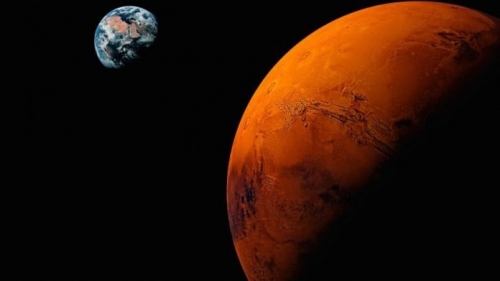Bahrain will be able to witness Planet Mars in a few hours!
Manama
Calling on all night sky enthusiasts who would like to witness the spectacular sight of planet Mars. Step outside and look up at nightfall - and you will see the Red Planet putting on a rare astronomical show. You can’t miss it, it’s the brightest star-like object in that part of the sky! In Bahrain, one can use a high-quality telescope or a good pair of binoculars to see the unusually bright, fire-yellow “star” tomorrow, Wednesday, starting at 2:30am (23:20 GMT Tuesday), when the Red Planet reaches what astronomers call “opposition”.
It is the actual moment when the Sun, Earth and Mars are aligned in a straight path so that the latter appears to rise in the east just as the sun sets in the west, making the sunlit side of the planet visible all night long. Mars will also appear the brightest to the naked eye and will appear notably larger to those observing it through a telescope. The opposition won’t occur again until the year 2035. But don’t worry, you’ll have plenty of time to see the Red Planet at its biggest and brightest. Mars will be one of the brightest objects in the night sky from now until the end of October.
‘Opposition’
The opposition of Mars happens roughly every two years, though technically speaking, Mars is tomorrow bigger and brighter than at any time since 2003. Mars reaches opposition only once every 26 months, when Earth manages to overtake the red planet in its tighter track around the Sun. But unlike Earth’s more circular orbit, Mars’s path is fairly elliptical. That means the distance between the two worlds varies, making some oppositions better than others. In 2003, Mars made its closest approach to Earth around opposition in nearly 60,000 years - a separation of just 56 million kilometres. The distance between the two at opposition can be over 100 million kilometres, as it happened in 2012.
Even though this coming week witnesses the moment of opposition, it was Tuesday of last week (6 October) that Mars and Earth actually made their closest approach in this 26-month cycle. A separation of just 62 million kilometres (39 million miles). At the last opposition, in 2018, Earth and Mars were just 58 million kilometres apart.
Glorious image
To capture the glorious image clearly, one has to use a 14-inch-diameter Celestron telescope. However, even a telescope half that size will show up all the major features on Mars quite easily. And if you’ve got a good pair of binoculars, you’ll certainly be able to make out that it’s actually a planet and not a star.
Most of the time Mars is not much to look at through a telescope, because it’s just a tiny, fuzzy, orange-hued dot; however, all that changes during opposition, when the planet becomes a disk filled with tantalising features. Even a small telescope with about a six-inch mirror can tease out surface details like the southern white ice cap and distinct, dark regions that are windswept rocky fields. How to see Mars For those excited to see this cosmic phenomenon with their own eyes, the instructions are simple. Go outdoors in early evening and look to the east. Mars will appear to the eye as bright orange star lurking just above the horizon. And don’t worry about getting it confused with something else in the solar system — during this time, nothing else in that section of the sky will be able to compete with its brightness or recognisable warm hue. In the event one can’t catch Mars at that time, don’t fret. By midnight, Mars will still be clearly visible, only by then it will hang high to the south. While Mars can be easily seen with the naked eye, those looking to get a better look should find a high-quality telescope. With a good telescope, stargazers can see Mars’ surface in detail.
Common misconception
Experts warn people to ignore a common misconception that tends to travel around the internet during times like this, that during opposition Mars will appear as full and large as Earth’s moon. Due to the sheer distance between Earth and Mars, the Red Planet will always look like a star to the unaided eye. But if one were to look at Mars during this time using a telescope with intense magnification capabilities (around 80x should do the trick) Mars will appear as roughly the same size as the moon would look like to the eye without a telescope.
In other words, Mars can be observed with just as much detail through a telescope as the moon can be seen with the human eye. Mars will be at its very closest and brightest tomorrow, and will progressively grow dimmer as it moves away from us in November.
Related Posts

